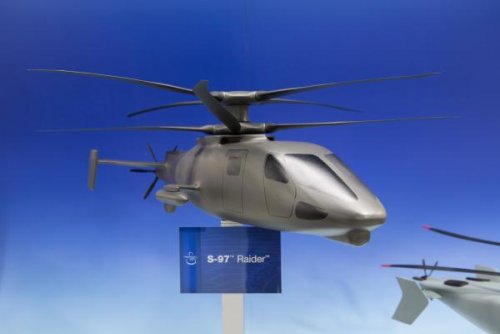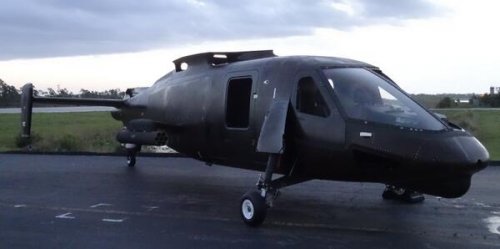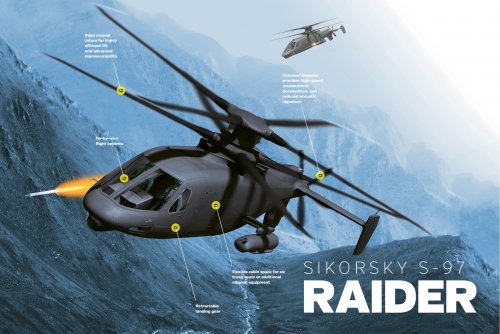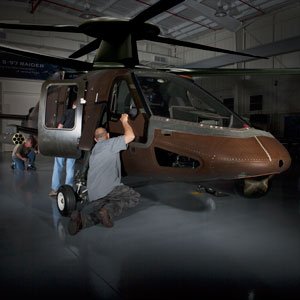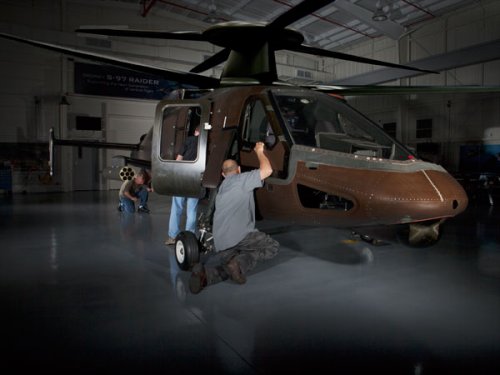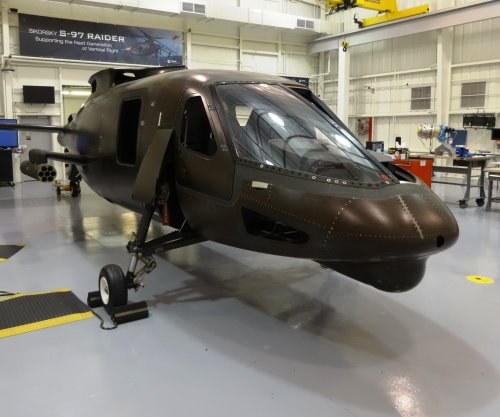You are using an out of date browser. It may not display this or other websites correctly.
You should upgrade or use an alternative browser.
You should upgrade or use an alternative browser.
Sikorsky X2 family
- Thread starter CammNut
- Start date
Moose said:That's an older mockup, the airframe has gone through some revisions since then.
The composite fuselage, built by Aurora Flight Sciences, for the first S-97 Raider prototype can be seen earlier in this topic. I replaced the previously posted image with a larger one.
http://www.secretprojects.co.uk/forum/index.php/topic,2768.msg205243.html#msg205243
- Joined
- 25 June 2009
- Messages
- 14,750
- Reaction score
- 6,111
Triton said:Moose said:That's an older mockup, the airframe has gone through some revisions since then.
The composite fuselage, built by Aurora Flight Sciences, for the first S-97 Raider prototype can be seen earlier in this topic. I replaced the previously posted image with a larger one.
In a 53-page topic, remember it's best to provide a link to the post in question. No-one wants to browse the whole shebang wondering where the heck that picture would be...
flateric said:http://www.flightglobal.com/news/articles/production-of-sikorskys-s-97-raider-continues-on-track-396081/
In April or May Sikorsky expects to begin drive train testing on an outdoor “transmission systems test bed.”
First flight is scheduled for late 2014. Initial test flights will be conducted with two test pilots, but Sikorsky may add a third test pilot to the programme after roughly 10h of flight time, says the company.
The pusher prop also will make Raider much more maneuverable than conventional helicopters, with the ability to hover in a nose-up or nose-down attitude, a feature that will let pilots more-effectively fire at targets.
Sikorsky’s stated price of $15 million each makes Raider a more expensive option for the army than conventional helicopters.
But the company says the US military will find value in Raider’s speed and capabilities, and it thinks Raider will become a serious contender for a scout replacement once test flights demonstrate its ability.
In addition, Sikorsky says oil companies are “very keen” on X-2 technology as an efficient executive transport to offshore oil platforms.
At least oil companies are "very keen" on X2 Technology. I don't see the United States Army or USSOCOM buying the S-97 Raider any time soon.
donnage99
ACCESS: Top Secret
- Joined
- 16 June 2008
- Messages
- 1,355
- Reaction score
- 861
When the private sector takes risks, we should encourage them. It's not only for the fact that the government doesn't have to spend on initial research (because the research money gonna go back into the unit price regardless) but that the said program move alot faster and have much more flexibility when free of government bureaucracy.
donnage99 said:When the private sector takes risks, we should encourage them. It's not only for the fact that the government doesn't have to spend on initial research (because the research money gonna go back into the unit price regardless) but that the said program move alot faster and have much more flexibility when free of government bureaucracy.
I immediately think of the Sikorsky S-67 Blackhawk that was entirely self-funded by Sikorsky when the Advanced Aerial Fire Support System (AAFSS) program was delayed. The United States Army evaluated the S-67 and the Bell 309 King Cobra before passing on both designs and creating the Advanced Attack Helicopter program. There are other examples of firms self-funding aviation projects and the United States military wasn't interested. There is probably less risk for Sikorsky with the S-97 Raider in that the design could be marketed in the civil utility helicopter market with little modification.
For-profit corporations do have internal processes, such as approvals from department heads, that must be followed during the development of new products. I don't know if they necessarily move alot faster or are more flexible when free of government bureaucracy.
- Joined
- 3 June 2011
- Messages
- 18,326
- Reaction score
- 12,186
Compare the cost and time taken between the GBU-28's entire development, testing, and first use and B61 Mod 12 upgrade. Granted it's not exactly apples to apples but ye gods.Triton said:For-profit corporations do have internal processes, such as approvals from department heads, that must be followed during the development of new products. I don't know if they necessarily move alot faster or are more flexible when free of government bureaucracy.
sferrin said:Compare the cost and time taken between the GBU-28's entire development, testing, and first use and B61 Mod 12 upgrade. Granted it's not exactly apples to apples but ye gods.
Maybe the government bureaucracy is burdensome on the contractor, but he gets paid during the development process and the customer demonstrates commitment to the product rather than the contractor facing the financial risk and uncertainty of whether he can recoup his costs later through sales of the finished product.
Sikorsky S-97 Raider mockup on display at HELI-EXPO 2014.
Source:
http://www.verticalmag.com/photography
https://m.ak.fbcdn.net/scontent-b.xx/hphotos-frc3/t1/1897012_10152213226156661_665041687_n.jpg
Source:
http://www.verticalmag.com/photography
https://m.ak.fbcdn.net/scontent-b.xx/hphotos-frc3/t1/1897012_10152213226156661_665041687_n.jpg
Attachments
donnage99
ACCESS: Top Secret
- Joined
- 16 June 2008
- Messages
- 1,355
- Reaction score
- 861
Triton said:Maybe the government bureaucracy is burdensome on the contractor, but he gets paid during the development process and the customer demonstrates commitment to the product rather than the contractor facing the financial risk and uncertainty of whether he can recoup his costs later through sales of the finished product.
If anything, facing a financial risk out of your own pocket should give even more incentive to be cost effective and expedient with your program. Capitalism 101
- Joined
- 3 October 2007
- Messages
- 1,960
- Reaction score
- 1,194
Triton said:donnage99 said:When the private sector takes risks, we should encourage them. It's not only for the fact that the government doesn't have to spend on initial research (because the research money gonna go back into the unit price regardless) but that the said program move alot faster and have much more flexibility when free of government bureaucracy.
I immediately think of the Sikorsky S-67 Blackhawk that was entirely self-funded by Sikorsky when the Advanced Aerial Fire Support System (AAFSS) program was delayed. The United States Army evaluated the S-67 and the Bell 309 King Cobra before passing on both designs and creating the Advanced Attack Helicopter program. There are other examples of firms self-funding aviation projects and the United States military wasn't interested. There is probably less risk for Sikorsky with the S-97 Raider in that the design could be marketed in the civil utility helicopter market with little modification.
For-profit corporations do have internal processes, such as approvals from department heads, that must be followed during the development of new products. I don't know if they necessarily move alot faster or are more flexible when free of government bureaucracy.
Interestingly, the S-67's original purpose was not as an AAFSS alternative (the S-66 was their entry), but as a project to keep Lockheed from getting a firm foothold in the rotary winged market. They wanted to show that you didn't need rigid rotor and other advanced techniques to produce a high performance large attack helo.
However, once the thing was sitting there where everyone could see it, there was a whole lot of interest, especially from foreign nations. In fact, had the bird not crashed at Farnborough, it was going to continue on for a sales tour, including, I believe, the Middle East where at least on nation was casting covetous eyes.
Regarding how fast private industry can move when freed from Gov't bureaucracy, Having been on both sides I can state that in the past, as long as the private company thinks they'll get a fair shot and there really is a buck to be made, they can move with stunning swiftness. It's no accident that whenever the balloon goes up and we need someting fast, one of the first thing the gov't does is say, "OK, forget the rules for a while" (until a competitor hires a lobbyist). This latter point concerns me. With so much "crony capitalism" nowadays, and given who's running a lot of corporations I'm not all that sure the big boys really are bothered that much by the bureaucracy. There is a tendency to go along with it because while they are used to and can afford all the lawyers and paper pushers to deal with it (especially if they eventually can recoup it in their billings), they know new or smaller entrants can not and so they can stifle competition.
Plus traditionally the bureaucracy is not always welcoming of companies doing too much on their own that the Washington folks can't control or take credit for.
Fair enough, F-14D.
Steve Weiner, chief engineer for Sikorsky Innovations, discusses the Sikorsky S-97 Raider at HELI-EXPO 2014.
http://vimeo.com/87772381
http://vimeo.com/87772381
- Joined
- 3 June 2006
- Messages
- 3,094
- Reaction score
- 3,949
CH-53K, S-92 VXX and now S-97 Raider. A great week for Sikorsky! 
Link: https://twitter.com/TheWoracle/status/464376751242870784/The first prototype of S-97 Raider high-speed helicopter taking shape and is scheduled to fly in December.
Attachments
- Joined
- 18 October 2006
- Messages
- 4,205
- Reaction score
- 4,894
Lets just hope for them that the military rotorcraft does not decline as badly as many perdict in the coming years. While they will likely continue to bring in funds on the H-60 for some time from their diversification and internationalization of the program, I am not sure that the H-53K is going to sell a significant number of units outside the USMC (Germany?) as Europe has gone on record as wanting a larger H-47 effort. S-97 will no doubt be a great rotorcraft, but if the US military does not buy into it, no one else will either I suspect. With Airbus and Bell having the light market sown up with ~8-10 M (US) helicopters with an endless number of after market add-on weapon and sensor a ~16M(US) aircraft without sponsorship may be a hard sell. Then there are ~450+ used H-58 about the get dumped on the market. Medium class is even more challenging with Airbus and the Russian rotorcraft industries competing very well. The Chinese Z-9 series has been starting to make its way into the market as well. So a good week, indeed, but I don't think the horizon is as blue for Sikorsky as it might seem today.
Good news for them is that I don't think the US Army is going to be able to resist their shiny new sports car.
Good news for them is that I don't think the US Army is going to be able to resist their shiny new sports car.
- Joined
- 3 June 2011
- Messages
- 18,326
- Reaction score
- 12,186
yasotay said:Lets just hope for them that the military rotorcraft does not decline as badly as many perdict in the coming years. While they will likely continue to bring in funds on the H-60 for some time from their diversification and internationalization of the program, I am not sure that the H-53K is going to sell a significant number of units outside the USMC (Germany?) as Europe has gone on record as wanting a larger H-47 effort. S-97 will no doubt be a great rotorcraft, but if the US military does not buy into it, no one else will either I suspect. With Airbus and Bell having the light market sown up with ~8-10 M (US) helicopters with an endless number of after market add-on weapon and sensor a ~16M(US) aircraft without sponsorship may be a hard sell. Then there are ~450+ used H-58 about the get dumped on the market. Medium class is even more challenging with Airbus and the Russian rotorcraft industries competing very well. The Chinese Z-9 series has been starting to make its way into the market as well. So a good week, indeed, but I don't think the horizon is as blue for Sikorsky as it might seem today.
Good news for them is that I don't think the US Army is going to be able to resist their shiny new sports car.
Let's not forget JMR down the road. I'd put them at the top of that list.
- Joined
- 18 October 2006
- Messages
- 4,205
- Reaction score
- 4,894
Don't fully disagree with you, but I think they will get a much more difficult run for the money on that program. Money changers buy by the pound when it comes to military rotorcraft and I have heard that the X-2 design is very heavy. Not so good for them when the people with the money are worried about cost vice capability.sferrin said:yasotay said:Lets just hope for them that the military rotorcraft does not decline as badly as many perdict in the coming years. While they will likely continue to bring in funds on the H-60 for some time from their diversification and internationalization of the program, I am not sure that the H-53K is going to sell a significant number of units outside the USMC (Germany?) as Europe has gone on record as wanting a larger H-47 effort. S-97 will no doubt be a great rotorcraft, but if the US military does not buy into it, no one else will either I suspect. With Airbus and Bell having the light market sown up with ~8-10 M (US) helicopters with an endless number of after market add-on weapon and sensor a ~16M(US) aircraft without sponsorship may be a hard sell. Then there are ~450+ used H-58 about the get dumped on the market. Medium class is even more challenging with Airbus and the Russian rotorcraft industries competing very well. The Chinese Z-9 series has been starting to make its way into the market as well. So a good week, indeed, but I don't think the horizon is as blue for Sikorsky as it might seem today.
Good news for them is that I don't think the US Army is going to be able to resist their shiny new sports car.
Let's not forget JMR down the road. I'd put them at the top of that list.
yasotay said:Don't fully disagree with you, but I think they will get a much more difficult run for the money on that program. Money changers buy by the pound when it comes to military rotorcraft and I have heard that the X-2 design is very heavy. Not so good for them when the people with the money are worried about cost vice capability.
How is the AVX design faring in FVL? AVX seems to be investing in marketing their solution.
"S-97 RAIDER to Enhance Army's Flight Capabilities"
Sikorsky's game-changing helicopter prototype improves agility at high and low speeds
By Mark Kakkuri
03.14.2014
Source:
http://www.gxonline.com/RAIDER
Source:
https://www.facebook.com/AHS.Intl
http://www.gxonline.com/RAIDER
Sikorsky's game-changing helicopter prototype improves agility at high and low speeds
By Mark Kakkuri
03.14.2014
Source:
http://www.gxonline.com/RAIDER
As Sikorsky Aircraft reaches the assembly midpoint of its self-funded S-97 RAIDER helicopter prototype, the Army National Guard could anticipate a game-changing evolution in its future aviation capabilities. The RAIDER helicopter’s coaxial counter-rotating rigid rotor blades combined with a pusher propeller will offer dramatic improvement in performance (speed, altitude, range and maneuverability) compared to traditional armed reconnaissance helicopters. Never-before-seen precision agility at both high and low speeds is expected to significantly change how the Guard could fly and fight. Sikorsky is readying its RAIDER prototype for flight demonstrations in 2015.
KEY FEATURES
High-performance flight while retaining helicopter maneuverability
Rigid coaxial rotor system with composite blades
Fly-by-wire flight controls reduce pilot workload
Active vibration control
All-composite airframe
50% better turn radius than conventional helicopters
Rudders and elevators that enhance maneuverability
Time-triggered Ethernet electronic architecture
Integrated engine exhaust that reduces IR signature
Cabin space for mission flexibility: space for six troop seats, internal auxiliary fuel and additional ammunition
DIMENSIONS
Length: 36 feet
Gross weight: 11,400 lbs.
Hover altitude: 10,000 feet at 95 F in armed configuration
Standard fuel endurance: More than 2.7 hrs.
Range: More than 600 km
Cruise speed: 220 knots
PAYLOAD
Hellfire missiles
2.75" rockets
.50 cal gun
7.62 mm gun
Source:
https://www.facebook.com/AHS.Intl
http://www.gxonline.com/RAIDER
Attachments
Is it strange that a rocket launcher is already attached to the pylon on the prototype airframe?
Could the retirement of the A-10 be good news for Sikorsky and the S-97 Raider?
"Foreign Militaries Eye Sikorsky S-97 Raider"
by Brendan McGarry Wednesday, May 7th, 2014 1:50 pm
Posted in Air
Source:
http://www.dodbuzz.com/2014/05/07/foreign-militaries-eye-sikorsky-s-97-raider/
by Brendan McGarry Wednesday, May 7th, 2014 1:50 pm
Posted in Air
Source:
http://www.dodbuzz.com/2014/05/07/foreign-militaries-eye-sikorsky-s-97-raider/
NASHVILLE, Tennessee — It hasn’t even flown yet and the U.S. Army program it was intended for was put on hold, possibly indefinitely.
But that hasn’t stopped foreign militaries from inquiring about when they might be able to buy the Sikorsky S-97 Raider, the company’s next-generation light-attack helicopter. The coaxial design features counter-rotating rotor blades and a push propeller, among other innovations, that will allow it to fly much faster and farther than today’s choppers.
Steve Engebretson, director of advanced military programs for Sikorsky, part of Hartford, Conn.-based United Technologies Corp., didn’t specify which militaries are interested in purchasing the Raider, but hinted that they’re closely watching the company’s self-funded technology development project.
“You can go to any of the major helicopter users around the world and we have talked to probably almost all of them,” he said on Tuesday at the Army Aviation Association of America’s annual conference, known as Quad A. “Some have more money. Some have more curiosity. Some have a greater need.”
Unfortunately for those with available funding, when the U.S. government might approve the product for export is unknown because the American military hasn’t yet decided to buy the aircraft. As Engebretson explained while standing near a full-scale model of the S-97 on the showroom floor, “It’s very difficult to export a next-generation capability if the U.S. doesn’t have it first.”
The Raider was designed to target a potentially $16 billion Army weapons program called the Armed Aerial Scout to develop a replacement for the OH-58 Kiowa Warrior, the smallest aircraft in the U.S. fleet. Due to automatic budget cuts, the service stopped the acquisition effort.
Engebretson said the program was “put on acquisition hold,” but not canceled outright, according to recent congressional testimony from Army Secretary John McHugh and Army Chief of Staff Gen. Raymond Odierno.
The company and its 30-some suppliers have spent tens of millions of dollars designing and developing coaxial technology. Sikorsky is building two Raiders, one of which is slated to fly for the first time later this year from the company’s developmental flight center in West Palm Beach, Fla., Engebretson said. He didn’t specify a date, but said most of the flight testing will take place in 2015.
Sikorsky in 2010 and 2011 flew an experimental prototype of the design called the X2 that reached speeds of up to 250 knots, or 290 miles per hour. By comparison, the Kiowa Warrior has a top speed of about 120 knots, or 140 miles per hour.
“She was a beauty, but she was straight and fast, and that’s all that aircraft was built to do — to prove the physics of combining a rigid rotor system with a push rotor,” Engebretson said. “Raider will now not only go fast, but as you can see we’re going to hang mock weapons on it. We’re going to represent the weight and drag of a combat aircraft — even though it won’t be real sensors and real weapons — and then we’re going to take it through real maneuvers.”
The goal is to show the U.S. military what’s possible with the technology in any size helicopter, Engebretson said. Sikorsky has also teamed with Boeing Co., which helps make the V-22 Osprey tilt-rotor aircraft, in offering the SB>1 Defiant, a larger coaxial design, for the Army’s Joint Multi-Role technology demonstrator program, or JMR.
While Sikorsky’s investment in the Raider and X2 technology represents a “huge industry commitment,” the result will only be prototypes, Engebretson noted. “This is not a production platform,” he said. “Whoever the first customer is has to be capable of funding and supporting a production development program.”
"Sikorsky Mulls Civil Version of S-97 Raider"
AINalerts » May 15, 2014
by Chad Trautvetter
Source:
http://www.ainonline.com/aviation-news/ainalerts/2014-05-15/sikorsky-mulls-civil-version-s-97-raider
AINalerts » May 15, 2014
by Chad Trautvetter
Source:
http://www.ainonline.com/aviation-news/ainalerts/2014-05-15/sikorsky-mulls-civil-version-s-97-raider
Sikorsky Aircraft vice president of research and engineering Mark Miller confirmed that the Stratford, Conn.-based helicopter manufacturer is considering plans to develop a civilian version of the S-97 Raider, which is a contender for the U.S. Army’s armed aerial scout program. The S-97, he said, is a production-ready, “scaled-up version of the X2 demonstrator,” with both helicopters having contrarotating rotor blades and a pusher propeller that enables high-speed forward flight. A civil variant of the S-97 would be “ideal” for offshore oil, search and rescue and VIP transport, according to Miller.
While the X2 achieved a maximum cruise speed of 253 knots, the target cruise speed of the mostly composite S-97 is 220 knots. At 11,000 pounds mtow, the eight-place S-97 will be approximately twice as heavy as the X2, Miller noted.
The first of two S-97 prototypes is currently being assembled at the Sikorsky Innovations facility in West Palm Beach, Fla., where a nearly complete fuselage was shown to journalists last week. Power-on tests are expected to start by the end of this month, while the rotor and pusher propeller systems will begin ground testing this fall. First flight is expected by year-end.
"Sikorsky plans late-2014 first flight for S-97"
Marina Malenic, Washington, DC - IHS Jane's Defence Weekly
06 May 2014
Source:
http://www.janes.com/article/37465/sikorsky-plans-late-2014-first-flight-for-s-97
Marina Malenic, Washington, DC - IHS Jane's Defence Weekly
06 May 2014
Source:
http://www.janes.com/article/37465/sikorsky-plans-late-2014-first-flight-for-s-97
Key Points
The high-speed helicopter is being developed entirely with private funding
Sikorsky now has 50 industry partners, and 38 of those have invested funds in the effort
United Technologies' Sikorsky Aircraft unit plans to fly its developmental S-97 Raider high-speed helicopter by 1 December, officials at the companies West Palm Beach, Florida, facility told reporters on 5 May.
Reporters viewed a nearly complete S-97 in a Sikorsky production hangar. A transmission and drive train, including a General Electric CT7 engine, are still to be installed.
Sikorsky started final assembly of the prototype, which features a co-axial rotor design, in September 2013. The company plans to spend approximately USD200 million on the development. Sikorsky currently boasts 50 industry partners on the self-funded effort, 38 of those being "investing partners", according to company officials.
Sikorsky is also using the technology, along with partner Boeing, as a basis from which to develop a high-speed rigid rotor co-axial design for the army's Joint Multi-Role Technology Demonstrator (JMR TD) programme. The JMR TD is the precursor to the army's estimated USD100 billion Future Vertical Lift (FVL) programme, which is meant to replace the army's UH-60 Black Hawk utility helicopters and AH-64 Apache attack helicopters.
The S-97 offers a variety of technologies drawn from the company's X2 technology demonstrator. Its composite fuselage was developed by Aurora Flight Sciences and consists of an integrated cockpit, cabin, and tail cone. The prototype also features counter-rotating main rotor blades for lift and forward flight, and a pusher propeller for high-speed acceleration and deceleration.
Sikorsky first tested the co-axial design in 2010 on the X2 demonstrator, at which time the helicopter demonstrated a 250 kt flight speed, which is about twice that of conventional helicopters. The X2 also provided an opportunity to develop low acoustic signature technology, according to Sikorsky. Company officials said the Raider prototype will improve on the X2, demonstrating a capacity to conduct precision manoeuvres at low speed, as well as high-G turning manoeuvres at more than 200 kt and engage in hot-day hover performance at altitudes of up to 10,000 ft.
Selected quotes from "The Rise of Radical New Rotorcraft"
by Jeff Wise
June 3, 2014
Source:
http://www.popularmechanics.com/technology/aviation/news/the-rise-of-radical-new-rotorcraft-16850989
Sikorsky technicians at a hangar in Florida work on the S-97 Raider, the first production-ready prototype of a compound-coaxial helicopter. (No larger image available.)
by Jeff Wise
June 3, 2014
In a few decades these futuristic rotorcraft could be as common in the skies as conventional helicopters are today. "This is a step change," says Steve Weiner, Sikorsky's director of engineering sciences. "It's going to be similar to when fixed-wing airplanes went from piston to jet engines."
If next-generation rotorcraft will be more capable than today's fleet, they are also going to be considerably more expensive. It takes a lot of power to go fast, and bigger engines add both weight and cost. "If you want to go above 150 knots [173 mph], you're going to have to pay a premium of 50 to 100 percent," says Richard Aboulafia, an aviation analyst with the Teal Group. Pentagon-funded demonstrator programs allow manufacturers to work out the kinks of new designs and bring down prices.
"Looking downstream, it's obvious that there's certain commercial applications of this technology," Bell's Keith Flail says. Some niches will be easier to exploit than others. "Offshore oil rigs could be a market," Aboulafia says. With exploration moving into ever-deeper waters, a vehicle that can make twice as many trips ferrying rig workers in the same amount of time will be worth the steep price tag to the big energy companies.
Another potential market, Aboulafia says, is the VIP market. Corporate executives and other wealthy individuals already take helicopters on short-hop trips, but more advanced rotorcraft could ferry passengers as far as 500 miles, avoiding airport hassles.
In a more critical application, medevac, speed can mean the difference between life and death. "There's a thing called golden hour," AVX's Troy Gaffey says. "If you can get someone to a hospital within that time, they're a lot more likely to live."
If these early markets pan out for tilt-rotors or compound-coaxial helicopters, there's no telling how many other uses they'll have. Right now vertical lift means a conventional helicopter, with niches occupied by the jump jet and the tilt rotor. Some day that relationship could reverse, if this new generation of vertical-lift aircraft becomes the norm, relegating conventional helicopters to the fringe. "You'll see the ratio change in that direction," Flail predicts confidently. "The evolution is coming."
Source:
http://www.popularmechanics.com/technology/aviation/news/the-rise-of-radical-new-rotorcraft-16850989
Sikorsky technicians at a hangar in Florida work on the S-97 Raider, the first production-ready prototype of a compound-coaxial helicopter. (No larger image available.)
Attachments
This Sikorsky patent mentions the swashplate:
Bearingless rotor blade assembly for a high speed rotary-wing aircraft
Publication number US7695249 B2
Publication type Grant
Application number US 11/565,669
Publication date Apr 13, 2010
Filing date Dec 1, 2006
Priority date Dec 1, 2006
Fee status Paid
Also published as EP2099676A2, 4 More »
Inventors Timothy A. Krauss, Pedro L. Cabrera, David H. Hunter
Original Assignee Sikorsky Aircraft Corporation
Export Citation BiBTeX, EndNote, RefMan
Source:
http://www.google.com/patents/US7695249
Bearingless rotor blade assembly for a high speed rotary-wing aircraft
Publication number US7695249 B2
Publication type Grant
Application number US 11/565,669
Publication date Apr 13, 2010
Filing date Dec 1, 2006
Priority date Dec 1, 2006
Fee status Paid
Also published as EP2099676A2, 4 More »
Inventors Timothy A. Krauss, Pedro L. Cabrera, David H. Hunter
Original Assignee Sikorsky Aircraft Corporation
Export Citation BiBTeX, EndNote, RefMan
Source:
http://www.google.com/patents/US7695249
Attachments
- Joined
- 3 June 2011
- Messages
- 18,326
- Reaction score
- 12,186
Looks like we missed this one from May:
"Sikorsky sets internal first flight goal for S-97"
May 6, 2014
Source:
http://www.flightglobal.com/news/articles/sikorsky-sets-internal-first-flight-goal-for-s-97-398906/
"Sikorsky sets internal first flight goal for S-97"
May 6, 2014
Source:
http://www.flightglobal.com/news/articles/sikorsky-sets-internal-first-flight-goal-for-s-97-398906/
Sikorsky has set an internal goal to fly the S-97 high-speed helicopter by 1 December to kick-off a demonstration aimed at securing a military customer for the self-funded project.
A computer display inside the S-97 final assembly hangar on 5 May showed the S-97 is "209 days to first flight," allowing for the event to occur no later than 1 December on schedule.
Sikorsky opened the doors to the S-97 production hangar to reporters as part of the rollout ceremony for the CH-53K King Stallion.
The hangar revealed the mostly composite airframe of the S-97 is almost fully assembled, with wiring and some avionics systems. But the aircraft still misses a transmission and drive train, including a General Electric CT7 engine, coaxial rotor and pusher propeller.
Sikorsky plans to power-on the S-97 electrical system by the end of May, once all the wiring is completed.
The S-97 is designed to be twice the weight of the high-speed Sikorsky X2 prototype that was retired in 2012 after achieving speeds over 250kt in level flight.
Sikorsky launched the S-97 – with an estimated $200 million price tag, including supplier contributions – to open a new market for military and perhaps later civilian high-speed helicopters.
The S-97 is aimed initially at replacing the Boeing MH-6M Little Bird fleet operated by the US Special Operations Command. The US Army also has a requirement for an armed aerial scout, although it plans to divest the Bell Helicopter OH-58 Kiowa Warrior fleet.
Press Releases
S-97 RAIDER™ Helicopter Powered On for First Time As Next-Gen Rotorcraft Moves Closer to First Flight
June 16, 2014
Source:
http://www.sikorsky.com/About+Sikorsky/News/Press+Details?pressvcmid=28ec91bc074a6410VgnVCM1000004f62529fRCRD
S-97 RAIDER™ Helicopter Powered On for First Time As Next-Gen Rotorcraft Moves Closer to First Flight
June 16, 2014
Source:
http://www.sikorsky.com/About+Sikorsky/News/Press+Details?pressvcmid=28ec91bc074a6410VgnVCM1000004f62529fRCRD
West Palm Beach, Florida - Sikorsky Aircraft Corp. today announced it has turned on electrical power for the first time to the S-97 RAIDER™ prototype helicopter, signaling successful installation of the avionics system and a major step toward completing the assembly of the new – and first – light tactical rotorcraft featuring X2 Technology™. Sikorsky is a subsidiary of United Technologies Corp. (NYSE: UTX).
The key milestone on the first of two aircraft planned to be built in the RAIDER program took place May 28, 2014, at Sikorsky’s Development Flight Center where the aircraft is being assembled. The successful powering on means that the cockpit multifunction displays and control display unit (CDU) are operational, as are the CDU controlled electronic circuit breakers. The aircraft will undergo electrical power and avionics Acceptance Test Procedures (ATPs) for the next several weeks, to complete the checkout of the remaining avionics, electrical, and flight control systems.
“This is a big milestone for a development program; the aircraft comes to life when power goes on,” said S-97 RAIDER Program Manager Mark Hammond. He also noted that several RAIDER suppliers played a critical role in achieving the “power on” milestone, including the Sikorsky Avionics Product Center, Esterline-Korry, Esterline-Mason, United Technologies Aerospace Systems (UTAS), Lockheed Martin, Garmin, Avionics Instruments, BAE, Honeywell, Pacific Scientific, Northrup Grumman, Meggitt, and LMS.
The aircraft is about halfway through the assembly process, with several key components in production and scheduled to be installed in the next few months.
“This is next-generation rotorcraft taking shape, with an aggressive schedule for getting air under the tires of the first RAIDER helicopter before the end of the year,” said Mark Miller, vice president of Research & Engineering. “We are making great progress, and in the meantime are keeping our interested customers keenly aware of the exceptional performance that this aircraft will bring. We are really looking forward to showing its value to the U.S. military.”
The RAIDER is targeted to fly by the end of 2014. Sikorsky plans to demonstrate the aircraft’s capabilities to the U.S. military beginning in 2015.
The S-97 RAIDER helicopter is a revolutionary rotorcraft that will deliver X2 Technology in a new light tactical rotorcraft designed to outmatch conventional military helicopters in speed, maneuverability, and high altitude operations. The fly-by-wire controlled helicopter will feature counter-rotating rigid main rotor blades for lift and forward flight, and a pusher propeller for high speed acceleration and deceleration.
Sikorsky proved the efficiency of the rigid rotor co-axial design in 2010 when its 6,000-lb. gross weight X2 demonstrator helicopter achieved 250-knot flight speed, or twice the speed of conventional helicopters. It also demonstrated low pilot workload and low acoustic signature.
Sikorsky Aircraft Corp., based in Stratford, Connecticut, is a world leader in helicopter design, manufacture, and service. United Technologies Corp., based in Hartford, Connecticut, provides a broad range of high technology products and support services to the aerospace and building systems industries.
This press release contains forward-looking statements concerning opportunities for development, production and sale of helicopters. Actual results may differ materially from those projected as a result of certain risks and uncertainties, including but not limited to changes in government procurement priorities and practices, budget plans, availability of funding and in the type and number of aircraft required; challenges in the design, development, production and support of advanced technologies; as well as other risks and uncertainties, including but not limited to those detailed from time to time in United Technologies Corporation’s Securities and Exchange Commission filings.
Attachments
Similar threads
-
-
Sikorsky considers shuttering, selling light helicopter lines
- Started by Triton
- Replies: 48
-
-
Baldwin Technology Mono Tilt Rotor (MTR) and demonstrator (MTR-SD)
- Started by CammNut
- Replies: 1
-



